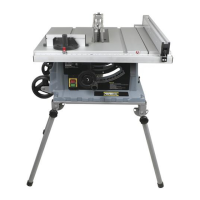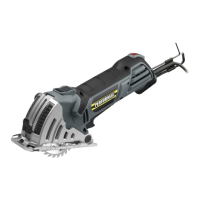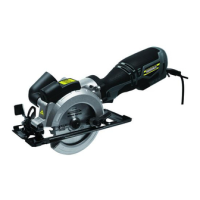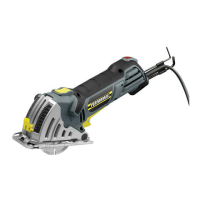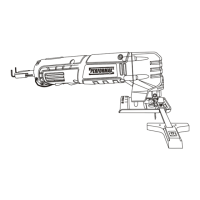Page 9
Page 9
SAFETY INSTRUCTIONS
25. DO NOT turn the motor switch on and
off rapidly. This could cause the blade to
loosen, which could create a hazard. Should
this ever occur, stand clear and allow the
saw blade to come to a complete stop.
Disconnect the saw from the power source,
and securely tighten the blade bolt.
26. NEVER leave the saw unattended while
connected to a power supply.
27. KEEP THE MOTOR AIR SLOTS clean
and free of chips or dust. To avoid motor
damage, the motor should be blown with
air or vacuumed frequently to keep sawdust
from interfering with the motor ventilation.
28. NEVER lift this tool by gripping the
cutting handle or by the fence. This may
cause misalignment. ALWAYS lock the saw
arm in the “DOWN” position and then carry
the saw by holding the base or lift it by the
carrying handle/support bracket.
ADDITIONAL INSTRUCTIONS
FOR SAFE OPERATION
The use of this tool
can generate and/or disburse dust, which
may cause serious and permanent
respiratory injuries or other injuries.
Always use NIOSH/OSHA approved
respiratory protection appropriate for the
dust exposure. Direct particles away from
the face and body.
1. Know your power tool. Read the
Operator’s Manual carefully. Learn the
applications and limitations, as well as the
specic potential hazards related to this
tool. Following this rule will reduce the risk
of electric shock, re or serious injury.
2. ALWAYS wear safety glasses or eye
shields when using this saw. Everyday
eye-glasses have only impact-resistant
lenses; they are NOT safety glasses. All
users and bystanders MUST wear eye
protection that conforms to ANSI Z87.1.
3. PROTECT your lungs. Wear a face mask
or a dust mask if the operation is dusty.
4. PROTECT your hearing. Wear
appropriate personal hearing protection
during use. Under some conditions and
duration of use, noise from this product
may contribute to hearing loss.
5. All visitors and bystanders must wear
the same safety equipment that the
operator of the saw wears.
6. INSPECT the tool cords periodically
and, if damaged, have them repaired by
a qualied person.
7. ALWAYS check the tool for damaged
parts. Before further use of the tool, a guard
or other part that is damaged should be
carefully checked to determine whether
it will operate properly and perform its
intended function. Check for misalignment
or binding of moving parts, broken parts,
and any other condition that may affect
the tool’s operation. A guard or other
part that is damaged should be properly
repaired or replaced by a qualied person.
8. Save these instructions. Refer to them
frequently and use them to instruct others
who may use this tool. If someone borrows
this tool, make sure they have these
instructions also.
WARNING:
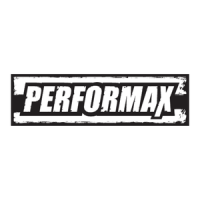
